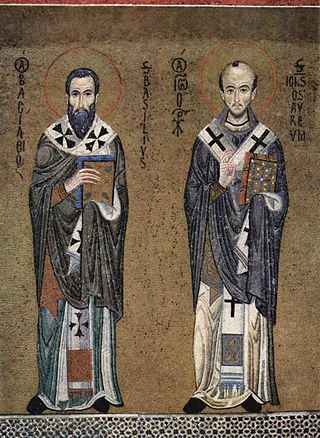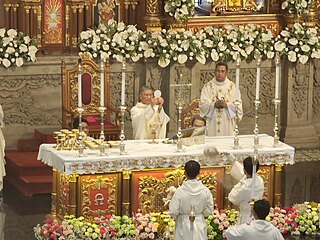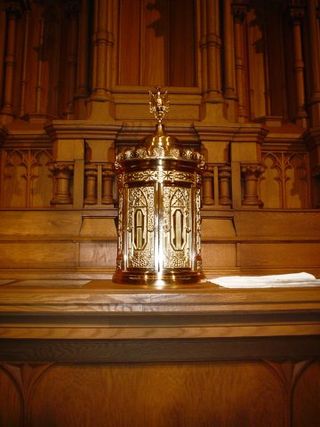Related Research Articles

The Eucharist, also known as Holy Communion, the Blessed Sacrament and the Lord's Supper, is a Christian rite that is considered a sacrament in most churches, and as an ordinance in others. Christians believe that the rite was instituted by Jesus at the Last Supper, the night before his crucifixion, giving his disciples bread and wine. Passages in the New Testament state that he commanded them to "do this in memory of me" while referring to the bread as "my body" and the cup of wine as "the blood of my covenant, which is poured out for many". According to the synoptic Gospels this was at a Passover meal.

Mass is the main Eucharistic liturgical service in many forms of Western Christianity. The term Mass is commonly used in the Catholic Church, Western Rite Orthodoxy, Old Catholicism, and Independent Catholicism. The term is also used in some Lutheran churches, as well as in some Anglican churches, and on rare occasion by other Protestant churches.

Divine Liturgy or Holy Liturgy is the usual name used in most Eastern Christian rites for the Eucharistic service.

A Pontifical High Mass, also called Solemn Pontifical Mass, is a Solemn or High Mass celebrated by a bishop using certain prescribed ceremonies. Although in modern English the word "pontifical" is almost exclusively associated with the pope, any bishop may be properly called a pontiff. Thus, the celebrant of a Pontifical High Mass may be the pope, any bishop or any other prelate who is allowed to wear pontificals.

Sacramental bread, also called Communion bread, Communion wafer, Sacred host, Eucharistic bread, the Lamb or simply the host, is the bread used in the Christian ritual of the Eucharist. Along with sacramental wine, it is one of two elements of the Eucharist. The bread may be either leavened or unleavened, depending on tradition.
The Fraction or fractio panis is the ceremonial act of breaking the consecrated sacramental bread before distribution to communicants during the Eucharistic rite in some Christian denominations.

A tabernacle or a sacrament house is a fixed, locked box in which the Eucharist is stored as part of the "reserved sacrament" rite. A container for the same purpose, which is set directly into a wall, is called an aumbry.

Intinction is the Eucharistic practice of partly dipping the consecrated bread, or host, into the consecrated wine before consumption by the communicant.

The Roman Rite is the most common ritual family for performing the ecclesiastical services of the Latin Church, the largest of the sui iuris particular churches that comprise the Catholic Church. The Roman Rite governs rites such as the Roman Mass and the Liturgy of the Hours as well as the manner in which sacraments and blessings are performed.

The antidoron is ordinary leavened bread which is blessed but not consecrated and distributed in certain Eastern Orthodox Churches and certain Eastern Catholic Churches that use the Byzantine Rite. It comes from the remains of the loaves of bread (prosphora) from which portions are cut for consecration as the Eucharist during the Divine Liturgy. The word Ἀντίδωρον means "instead of gifts", i.e., "instead of the Eucharistic gifts". A blessed bread akin to antidoron, pain bénit, is used in some French and Canadian Latin Catholic churches as a substitute for those unable to receive the Eucharist.

During the Liturgy of the Eucharist, the second part of the Mass, the elements of bread and wine are considered to have been changed into the veritable Body and Blood of Jesus Christ. The manner in which this occurs is referred to by the term transubstantiation, a theory of St. Thomas Aquinas, in the Roman Catholic Church. Members of the Orthodox, Anglican, and Lutheran communions also believe that Jesus Christ is really and truly present in the bread and wine, but they believe that the way in which this occurs must forever remain a sacred mystery. In many Christian churches, some portion of the consecrated elements is set aside and reserved after the reception of Communion and referred to as the reserved sacrament. The reserved sacrament is usually stored in a tabernacle, a locked cabinet made of precious materials and usually located on, above, or near the high altar. In Western Christianity usually only the Host, from Latin: hostia, meaning "victim", is reserved, except where wine might be kept for the sick who cannot consume a host.

Blood of Christ, also known as the Most Precious Blood, in Christian theology refers to the physical blood actually shed by Jesus Christ primarily on the Cross, and the salvation which Christianity teaches was accomplished thereby, or the sacramental blood (wine) present in the Eucharist or Lord's Supper, which some Christian denominations believe to be the same blood of Christ shed on the Cross.

The Mass is the central liturgical service of the Eucharist in the Catholic Church, in which bread and wine are consecrated and become the body and blood of Christ. As defined by the Church at the Council of Trent, in the Mass "the same Christ who offered himself once in a bloody manner on the altar of the cross, is present and offered in an unbloody manner". The Church describes the Mass as the "source and summit of the Christian life", and teaches that the Mass is a sacrifice, in which the sacramental bread and wine, through consecration by an ordained priest, become the sacrificial body, blood, soul, and divinity of Christ as the sacrifice on Calvary made truly present once again on the altar. The Catholic Church permits only baptised members in the state of grace to receive Christ in the Eucharist.

In Eastern and Western Christian liturgical practice, the elevation is a ritual raising of the consecrated Sacred Body and Blood of Christ during the celebration of the Eucharist. The term is applied especially to that by which, in the Catholic Roman Rite of Mass, the Sacred Body of Christ (Host) and the chalice containing the Most Precious Blood of Christ are each lifted up and shown to the congregation immediately after each is consecrated. The term may also refer to a musical work played or sung at that time.

Sacramental wine, Communion wine, altar wine, or wine for consecration is wine obtained from grapes and intended for use in celebration of the Eucharist. It is usually consumed after sacramental bread.

In Christianity, concelebration is the presiding of a number of presbyters at the celebration of the Eucharist with either a presbyter, bishop, or archbishop as the principal celebrant and the other presbyters and (arch)bishops present in the chancel assisting in the consecration of the Eucharist. The concelebrants assist the principal celebrant by reciting the Words of Consecration together with them, thus effecting the change of the eucharistic elements. They may also recite portions of the Eucharistic Prayer.

Communion under both kinds in Christianity is the reception under both "species" of the Eucharist. Denominations of Christianity that hold to a doctrine of Communion under both kinds may believe that a Eucharist which does not include both bread and wine as elements of the religious ceremony is not valid, while others may consider the presence of both bread and wine as preferable, but not necessary, for the ceremony. In some traditions, grape juice may take the place of wine with alcohol content as the second element.
In Lutheranism, the Eucharist refers to the liturgical commemoration of the Last Supper. Lutherans believe in the real presence of Christ in the Eucharist, affirming the doctrine of sacramental union, "in which the body and blood of Christ are truly and substantially present, offered, and received with the bread and wine."

The Liturgy of Addai and Mari is the Eucharistic liturgy belonging to the East Syriac Rite and was historically used in the Church of the East of the Sasanian (Persian) Empire. This liturgy is traditionally attributed to Saint Addai and Saint Mari. It is currently in regular use in the Assyrian Church of the East, the Ancient Church of the East, the Syro-Malabar Catholic Church of India, and the Chaldean Catholic Church. The latter two are Eastern Catholic churches in full communion with the Holy See of Rome.
Holy Leaven, also known as Malka, is a powder added to the sacramental bread used in the Eucharist of both the Ancient Church of the East and the Assyrian Church of the East and historically in the Church of the East. Both churches hold the Holy Leaven to be one of their seven sacraments. The Syro-Malabar Church in India, which was historically a part of the Church of the East, also uses Holy Leaven to prepare sacramental bread in several churches whereas unleavened bread is also in use. There are two rituals associated with the Holy Leaven: its addition to sacramental bread before it is baked, and the annual renewal of the Holy Leaven itself.
References
- ↑ Encyclopedia.Com: Our Sunday Visitor's Catholic Encyclopedia, pg. 437 The rite of committing consists of placing a small particle of the consecrated Bread into the chalice. This custom derives from the fermentum practice (literally, "leaven"). The fermentum was originally part of the Eucharistic Bread consecrated by the Pope in Rome (as attested in the letter of Pope St. Innocent 1 in A.D. 416 to Bishop Decentius of Gubbio) and then sent to the various tituli (parish churches) in the city to denote the unity of the one Catholic community despite their having to celebrate separate Eucharists.
- 1 2 Freestone, William Herbert (1917). The sacrament reserved : a survey of the practice of reserving the Eucharist, with special reference to the communion of the sick, during the first twelve centuries. Princeton Theological Seminary Library. London : A.R. Mowbray ; Milwaukee : The Young Churchman Co. pp. 73-80.
- ↑ Encyclopedia.Com: Our Sunday Visitor's Catholic Encyclopedia, pg. 255 The origins of this rite [liturgical commixture] are to be found in fermentum, during which a piece of the consecrated Bread was broken off and sent to be part of another Eucharistic celebration to show the essential unity of the Church in the Eucharistic Sacrifice. When this was no longer done, the piece was dropped into the chalice and medieval allegorical explanations were developed to explain the practice.
- ↑ Eusebius of Caesarea's Church History, Book 5, Chapter 24, Paragraph 17 But though matters were in this shape, they communed together, and Anicetus conceded the administration of the eucharist in the church to Polycarp, manifestly as a mark of respect. And they parted from each other in peace, both those who observed, and those who did not, maintaining the peace of the whole church.
- ↑ Klauser, Theodor (1979). A short History of the Western Liturgy. Oxford University press. pp. 66–67. ISBN 0-19-213223-7.